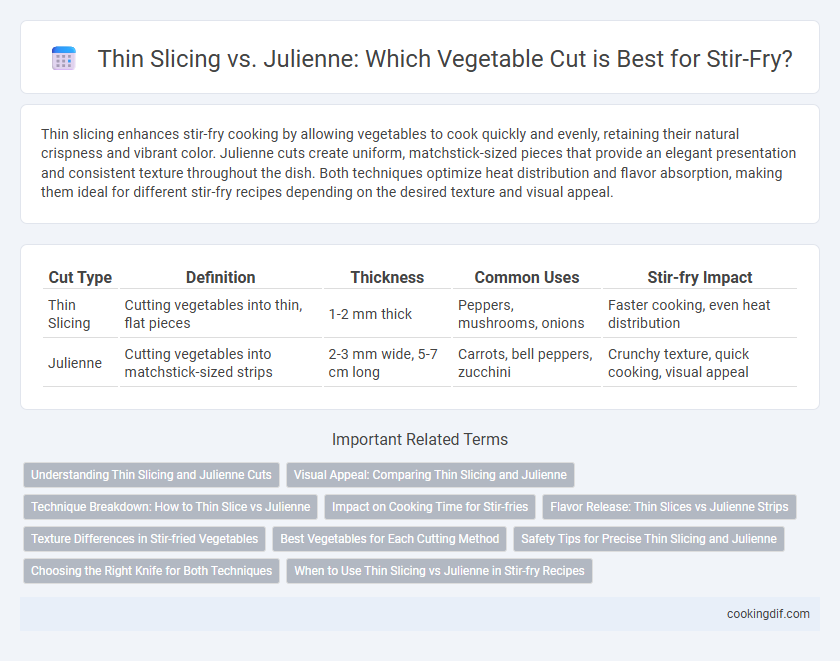Thin slicing enhances stir-fry cooking by allowing vegetables to cook quickly and evenly, retaining their natural crispness and vibrant color. Julienne cuts create uniform, matchstick-sized pieces that provide an elegant presentation and consistent texture throughout the dish. Both techniques optimize heat distribution and flavor absorption, making them ideal for different stir-fry recipes depending on the desired texture and visual appeal.
Table of Comparison
| Cut Type | Definition | Thickness | Common Uses | Stir-fry Impact |
|---|---|---|---|---|
| Thin Slicing | Cutting vegetables into thin, flat pieces | 1-2 mm thick | Peppers, mushrooms, onions | Faster cooking, even heat distribution |
| Julienne | Cutting vegetables into matchstick-sized strips | 2-3 mm wide, 5-7 cm long | Carrots, bell peppers, zucchini | Crunchy texture, quick cooking, visual appeal |
Understanding Thin Slicing and Julienne Cuts
Thin slicing and julienne cuts are essential techniques in stir-fry cooking that influence texture and cooking time. Thin slicing involves cutting vegetables into uniform, thin pieces that cook quickly and evenly, ideal for ingredients like mushrooms or peppers. Julienne cuts create long, matchstick-like strips that provide a crisp texture and visually appealing presentation, commonly used for carrots and zucchini in stir-fry dishes.
Visual Appeal: Comparing Thin Slicing and Julienne
Thin slicing creates broad, even vegetable strips that offer a smooth, elegant visual appeal ideal for stir-fries, enhancing the dish's uniformity and cooking consistency. Julienne cuts produce long, matchstick-like strips that add texture contrast and a dynamic, professional appearance, emphasizing precision and finesse. Both techniques elevate the dish's aesthetic but cater to different styles: thin slicing emphasizes simplicity and cohesiveness, while julienne highlights intricate detail and crispness.
Technique Breakdown: How to Thin Slice vs Julienne
Thin slicing involves cutting vegetables into uniform, flat pieces typically about 1-2 millimeters thick, ideal for quick cooking and even heat distribution in stir-fry. Julienne cutting requires slicing vegetables into long, matchstick-like strips approximately 3-5 millimeters wide and 5-7 centimeters long, promoting a crisp texture and visually appealing presentation. Mastery of knife control, consistent pressure, and proper grip is essential for achieving precision and uniformity in both thin slicing and julienne techniques, enhancing stir-fry texture and cooking efficiency.
Impact on Cooking Time for Stir-fries
Thin slicing vegetables reduces cooking time significantly in stir-fries due to increased surface area and faster heat penetration. Julienne cuts, while still promoting quick cooking, tend to retain more texture and require slightly longer stir-frying to achieve tenderness. Choosing between thin slices and julienne directly influences stir-fry crispness and overall dish timing.
Flavor Release: Thin Slices vs Julienne Strips
Thin slicing vegetables enhances flavor release by increasing surface area, allowing heat to penetrate quickly and intensify natural aromas during stir-frying. Julienne strips, while similarly maximizing surface exposure, create uniform, slender pieces that cook evenly and maintain a slightly crisper texture, balancing flavor concentration with fresh mouthfeel. Both cutting techniques optimize taste extraction, but thin slices prioritize immediate, robust flavor infusion, whereas julienne strips offer a harmonious blend of flavor and texture.
Texture Differences in Stir-fried Vegetables
Thin slicing creates delicate, tender vegetable pieces that cook quickly and retain a slight crispness, enhancing a smooth texture in stir-fried dishes. Julienne cuts produce thin, matchstick-like strips that maintain firmness and provide a satisfying crunch, adding contrast and bite to the stir-fry. The choice between thin slicing and julienne directly influences the overall mouthfeel and balance of textures in vegetable stir-fries.
Best Vegetables for Each Cutting Method
Thin slicing is ideal for vegetables like bell peppers, onions, and zucchini, allowing for quick and even cooking in stir-fries, while julienne cuts suit firmer vegetables such as carrots, celery, and green beans, providing a crisp texture and uniform appearance. Thin slices maximize surface area for faster caramelization, enhancing flavor depth, whereas julienne cuts promote consistent cooking times and an attractive presentation. Choosing the right cut depends on the vegetable's texture and desired cooking speed, optimizing both taste and visual appeal in stir-fry dishes.
Safety Tips for Precise Thin Slicing and Julienne
Maintaining a sharp knife and using a stable cutting board are essential safety tips for achieving precise thin slicing and julienne cuts in stir-fry preparation. Proper hand placement, such as the claw grip technique, minimizes the risk of injury while ensuring uniform vegetable slices that cook evenly. Consistent practice and attention to technique improve cutting accuracy and enhance the overall texture and presentation of stir-fried dishes.
Choosing the Right Knife for Both Techniques
Selecting the right knife significantly impacts the precision of thin slicing and julienne vegetable cuts in stir-fry preparation. A sharp chef's knife with a thin, tapered blade offers excellent control for uniform thin slices, while a santoku knife's shorter, wider blade enhances precision for julienne cuts, allowing for consistent matchstick-sized strips. Proper knife maintenance and handling ensure clean cuts, preserving vegetable texture and promoting even cooking in stir-fry dishes.
When to Use Thin Slicing vs Julienne in Stir-fry Recipes
Thin slicing vegetables suits stir-fry dishes with quick cooking times, ensuring even heat distribution and tender texture. Julienne cuts, with their uniform matchstick shape, enhance presentation and crispiness in recipes requiring slightly longer cooking or retaining a bit of crunch. Choosing between thin slicing and julienne depends on desired cooking speed and textural contrast in the stir-fry.
Thin slicing vs Julienne for vegetable cuts Infographic

 cookingdif.com
cookingdif.com